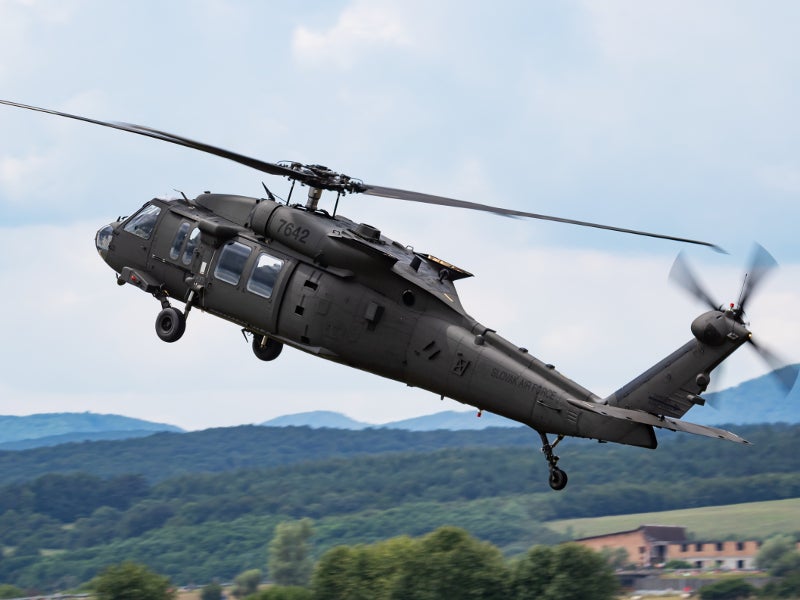Achieving Excellence: Trick Techniques for UH 60 Helicopter Upkeep
Wiki Article
Comprehending the Mechanics and Design Behind Uh 60 Helicopters
The UH-60 helicopter, frequently recognized as the Black Hawk, stands as a pinnacle of contemporary rotorcraft innovation, symbolizing a mix of durable engineering and intricate mechanics. As we peel off back the layers of the UH-60's style, a globe of complex systems and meticulous design comes to light.Background of UH-60 Helicopters
The history of UH-60 helicopters traces back to the late 1970s when the USA Military sought a versatile and innovative energy helicopter to change its aging fleet. In reaction to this need, the Sikorsky Aircraft Corporation developed the UH-60 Black Hawk helicopter. Presented in 1979, the UH-60 promptly became a staple in armed forces procedures due to its outstanding capabilities.
The UH-60 was made to stand out in a variety of goals, consisting of army transportation, medical evacuation, electronic warfare, and special procedures. Its capacity to adapt to different duties made it a valuable property to the united state Military and various other military forces all over the world
Throughout the years, the UH-60 system has actually undertaken a number of upgrades and variations to improve its efficiency and equal developing mission demands. These helicopters have seen considerable service in disputes such as the Gulf Battle, Afghanistan, and Iraq, showcasing their reliability and convenience in diverse operational atmospheres. The UH-60's abundant history is a testimony to its long-lasting legacy as a top utility helicopter.

Engine and Power Equipments
Utilizing sophisticated propulsion technology, UH-60 helicopters are outfitted with sophisticated engine and power systems to ensure optimal efficiency and dependability in a variety of operational circumstances. The UH-60, commonly recognized as the Black Hawk, is powered by 2 General Electric T700-GE-701D engines, each qualified of delivering up to 1,940 shaft horsepower. These turboshaft engines give the needed drive for the helicopter to execute its objectives effectively, including troop transport, medical discharge, and fight assistance.
Blades System and Aerodynamics
How do the blades system and the rules of aerodynamics of UH-60 helicopters add to their functional efficiency and flight capabilities? The blades system of the UH-60 helicopter plays a crucial function in providing lift and propulsion. The UH-60 features a four-bladed, totally articulated rotor system that allows for high maneuverability and stability throughout trip. This style makes it possible for the helicopter to carry out a broad array of objectives, from transport and medical discharge to deal with procedures.The rules of aerodynamics additionally play a key function in the efficiency of UH-60 helicopters. The streamlined body and rotor blade design reduce drag, allowing the helicopter to accomplish higher rates and far better gas effectiveness. The wind resistant layout of the UH-60 also adds to its ability to run in diverse environmental conditions, consisting of warm temperatures and high elevations.
Avionics and Trip Control Equipment

In its detailed coordination with the blades system and the rules of aerodynamics of UH-60 helicopters, the avionics and flight control systems develop an important network of technologies shaping the airplane's functional capabilities. Avionics incorporate the digital systems made use of for communication, navigating, and keeping track of numerous aircraft functions. In the UH-60, these systems include digital screens, interaction radios, GPS navigating, climate radar, and autopilot systems. These avionics systems supply vital information to the pilots, improving situational awareness and making sure efficient and secure procedure of the helicopter.
The trip control systems of the published here UH-60 are in charge of converting the pilot's inputs right into the appropriate modifications to the blades system, making certain stable flight and maneuverability. These systems include hydraulic actuators, servos, and computer systems that interact to regulate the tail and major rotors, along with other trip control surfaces. By precisely managing the helicopter's flight dynamics, these systems allow pilots to do a vast array of missions, from transport and search-and-rescue to battle procedures, with accuracy and self-confidence.
Role and Applications in Air Travel
Avionics systems in UH-60 helicopters incorporate a variety of electronic systems that aid in navigation, communication, monitoring, and managing various airplane features. These systems consist of electronic displays, auto-pilot systems, communication radios, General practitioner navigation tools, and weather radar. In addition, these systems include safety attributes such as autopilot settings, terrain recognition advising systems, and security enhancement systems to boost the total security and functional abilities of content the UH-60 helicopters in numerous goals, including army transport, medical emptying, search and rescue, and aerial firefighting.Final Thought
Finally, the UH-60 helicopter is a flexible airplane with an abundant background and progressed engineering. Its engine and power systems, blades system, the rules of aerodynamics, avionics, and flight control systems all collaborate to make it a reliable and dependable equipment. The UH-60's function and applications in aeronautics are vast, varying from army operations to look and rescue missions. Its continued growth and usage show its relevance in the area of aeronautics (uh 60).In its elaborate control with the rotor system and aerodynamics of UH-60 helicopters, the avionics and trip control systems form a critical network of modern technologies forming the airplane's operational capacities.The trip control systems of the UH-60 are responsible for equating the pilot's inputs right into the appropriate adjustments to the blades system, guaranteeing secure flight and ability to more helpful hints move. Avionics systems in UH-60 helicopters encompass a variety of electronic systems that aid in navigation, interaction, tracking, and controlling various aircraft functions. Furthermore, these systems incorporate security attributes such as autopilot modes, terrain recognition warning systems, and stability enhancement systems to enhance the overall security and functional capabilities of the UH-60 helicopters in different goals, including troop transport, clinical discharge, search and rescue, and airborne firefighting.
Its engine and power systems, blades system, the rules of aerodynamics, avionics, and trip control systems all work together to make it a reliable and trusted machine.
Report this wiki page